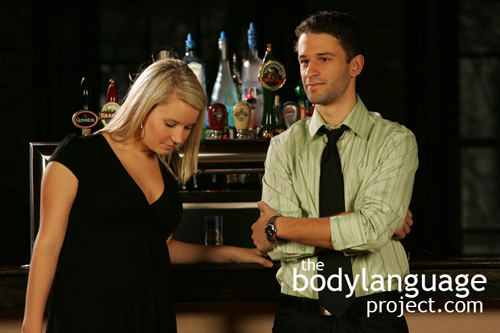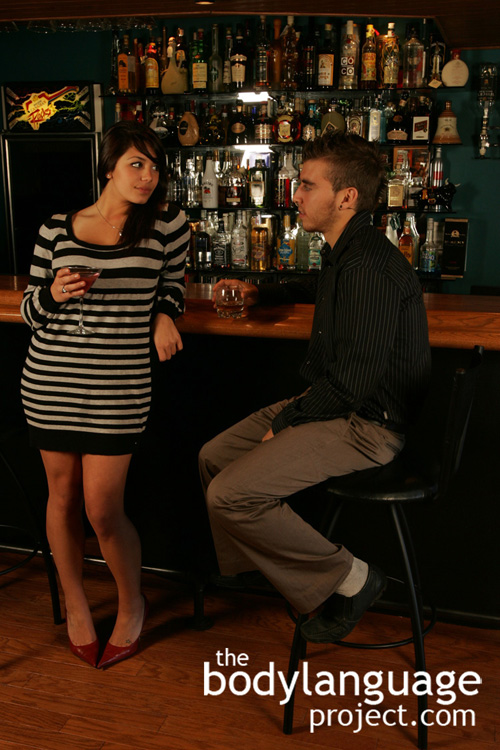Body Language of Sideways Glance Over Raised Shoulder
 Cue: Sideways Glance Over Raised Shoulder.
Cue: Sideways Glance Over Raised Shoulder.
Synonym(s): Looking Over Raised Shoulder.
Description: a) A woman will turn her back slightly facing the object of her interest, raise her shoulder, and gaze adoringly over it with eyes cast upward. The cue is made more salient in a strapless dress. b) Sometimes referred to as “Stealing A Look” but in this case, the shoulder is not raised, the look is quick so as to avoid detection, and the head is not lowered and eyes not cast upward.
In One Sentence: Looking over a raised shoulder is a flirty gesture.
How To Use it: Women can create sexual interest by peering over a raised shoulder. The cue is more potent when done over a nude shoulder such as a strapless dress. To compound the cue, couple it with slightly raised eyes that briefly make eye contact as well as a coy smile. If the desired results are not achieved, simply repeat the cue.
Context: a) Dating b) General.
Verbal Translation: a) “I’m looking over my raised shoulder to tease and flirt by showing off my curvy shoulder and making you do a bit of chasing to secure my full one-on-one attention.” b) “I’m glancing quickly over my shoulder to steal a look without being noticed.”
Variant: See Room Encompassing Glance (the), Looking Askance.
Cue In Action: a) She knew all the right buttons to push to get his attention. She removed her light overcoat, raised her shoulder, turned in his direction, smiled coyly, batted her eyelashes, before lowering her head and turning back for a sip of her drink. He was sent into fits. He knew it was an invitation to approach.
b) He kept glancing quickly over his shoulder at the angry girl. When she looked up, he quickly snapped his head back and continued the conversation with his buddy. He didn’t like her and certainly didn’t want her to know that he had noticed she was there, lest she come over and confront him.
Meaning and/or Motivation: Women do this flirty gesture as they gaze at men of interest. Instead of squaring themselves off and looking straight into his eyes, her body faces away and she looks over the shoulder which seductively teases him. This posture emphasizes the curviness of the shoulder and exposes the vulnerable neck. It is particularly alluring when done by women wearing a strapless outfit!
The power of the cue relies on its ability to tease through mystery. A bit of hide-and-seek mixed in with sexual curves of the shoulder as well as easy eyes cast upward showing submission. The entire cue, when done properly, is both seductive and coy.
In a general context, the sideways glance is done to steal a look without being caught. This might indicate that a person is trying to remain secretive, is talking behind another person’s back, or doesn’t want the other person to notice them. Stealing a look can also mean that sexual interest exists but that a person wishes to be covert.
Cue Cluster: a) Watch for eyes and head lowered or quick eye contact, wrist and palm exposure and flirty smile. b) Watch for darting eyes that don’t want to be caught looking. The shoulders will remain lowered, there will be no gazing or smiling.
Body Language Category: Amplifier, Courtship display, Childlike playfulness, Eye Language, Indicators of sexual interest (IOsI), Intention movements, Liking, Tie signals.
Resources:
Abrahams, Matthewf. Perceiving flirtatious communication: An exploration of the perceptual dimensions underlying judgments of flirtatiousness. Journal of Sex Research. 1994. 31(4): 283-292.
Aguinis, Herman ; Simonsen, Melissam. ; Pierce, Charlesa. Effects of Nonverbal Behavior on Perceptions of Power Bases. The Journal of Social Psychology. 1998. 138(4): 455-469.
Aguinis, Herman ; Henle, Christinea. Effects of Nonverbal Behavior on Perceptions of a Female Employee’s Power Bases. The Journal of Social Psychology. 2001 141(4): 537-549.
Argyle, M., & Dean, I. Eye contact, distance and affiliation. Sociometry, 1965, 28, 289-304.
Anderson, Uriah S. ; Perea, Elaine F. ; Vaughn Becker, D. ; Ackerman, Joshua M. ; Shapiro, Jenessa R. ; Neuberg, Steven L. ; Kenrick, Douglas T. I only have eyes for you: Ovulation redirects attention (but not memory) to attractive men. Journal of Experimental Social Psychology. 2010. 46(5): 804-808.
Ariel, Robert and Castel, Alan. Eyes wide open: enhanced pupil dilation when selectively studying important information. Experimental Brain Research, 2014. 232(1):.337-344.
Bijleveld E, Custers R, Aarts H (2009) The unconscious eye opener: pupil size reveals strategic recruitment of resources upon presentation of subliminal reward cues. Psychol Sci 20:1313–1315
Bolmont, Mylene; John T. Cacioppo and Stephanie Cacioppo. Love Is in the Gaze: An Eye-Tracking Study of Love and Sexual Desire. Psychological Science July 16, 2014. Published online before print. July 16, 2014, doi: 10.1177/0956797614539706
http://bodylanguageproject.com/articles/lust-like-eyes-read-body-language-eyes/
Costa, M., Menzani, M., & Ricci Bitti, P. E. Head canting in paintings: An historical study. Journal of Nonverbal Behavior. 2001. 25: 63–73.
Costa, M., & Ricci Bitti, P. E. Face-ism effect and head canting in one’s own and others’ photographs. European Psychologist. 2000. 5: 293–301.
Cari D. Goetz; Judith A. Easton; David M.G. Lewis; David M. Buss. Sexual Exploitability: Observable Cues And Their Link To Sexual Attraction. Evolution and Human Behavior. 2012; 33: 417-426.
http://bodylanguageproject.com/articles/victim-blaming-or-useful-information-in-preventing-rape-and-sexual-exploitation/
Cantú, Stephanie M ; Simpson, Jeffry A ; Griskevicius, Vladas ; Weisberg, Yanna J ; Durante, Kristina M ; Beal, Daniel J. Fertile and Selectively Flirty. Psychological Science. 2014. 25(2): 431-438.
Clark, A. Attracting Interest: Dynamic Displays of Proceptivity Increase the Attractiveness of Men and Women. Evolutionary Psychology. 2008., 6(4), 563-574.
http://bodylanguageproject.com/articles/risky-versus-proceptive-nonverbal-sexual-cues/
Chen, Yi-Chia ; Yeh, Su-Ling. Look into my eyes and I will see you: Unconscious processing of human gaze. Consciousness and Cognition. 2012 21(4): 1703-1710.
Colonnesi, Cristina; Susan M. Bogels; Wieke de Vente and Mirjana Majdandzic. What Coy Smiles Say About Positive Shyness in Early Infancy. Infancy. 2013. 18(2): 202–220. ISSN: 1525-0008 print / 1532-7078 online
DOI: 10.1111/j.1532-7078.2012.00117.x
http://bodylanguageproject.com/articles/nonverbal-meaning-coy-smiles-infants/
Ekman. 1982. Felt, false, and miserable smiles. Journal of nonverbal behavior. 6(4): 238-258.
Emery, N.J. The eyes have it: the neuroethology, function and evolution of social gaze. Neuroscience and Biobehavioral Reviews. 2000. 24(6): 581-604.
Krumhuber, E., Manstead, A., & Kappas, A. Temporal Aspects of Facial Displays in Person and Expression Perception: The Effects of Smile Dynamics, Head-tilt, and Gender. Journal of Nonverbal Behavior. 2007. 31(1), 39-56.
http://bodylanguageproject.com/articles/slow-onset-smile-best/
Golle, Jessika; Fred W.; Mast and Janek S. Lobmaier. Something to Smile About: The Interrelationship Between Attractiveness and Emotional Expression. Cognition and Emotion, 2014. 28:2: 298-310. DOI: 10.1080/02699931.2013.817383.
http://bodylanguageproject.com/articles/smiles-arent-just-cameras/
Guéguen, N. The Effect Of A Woman’s Smile On Men’s Courtship Behavior. Social Behavior and Personality. 2008. 36(9): 1233-1236.
http://bodylanguageproject.com/articles/how-women-can-use-a-simple-smile-to-attract-men/
Guéguen, N., & Fischer-Lokou, J. (2004). Hitchhiker’s Smiles And Receipt Of Help. Psychological Reports. 94: 756-760.
Greer, Arlettee. ; Buss, Davidm. Tactics for promoting sexual encounters
Journal of Sex Research. 1994. 31(3): 185-201.
Grammer, K. (1990). Strangers meet: Laughter and nonverbal signs of interest in opposite-sex encounters. Journal of Non? verbal Behavior, 14, 209-237.
Goetz, Cari D.; Judith A. Easton; David M.G. Lewis; David M. Buss. Sexual Exploitability: Observable Cues And Their Link To Sexual Attraction. Evolution and Human Behavior. 2012; 33: 417-426.
http://bodylanguageproject.com/articles/victim-blaming-or-useful-information-in-preventing-rape-and-sexual-exploitation/
Goetz, Cari D.; Judith A. Easton; Cindy M. Meston. The Allure of Vulnerability: Advertising Cues to Exploitability as a Signal of Sexual Accessibility. Personality and Individual Differences. 2013. 62: 121-125. http://dx.doi.org/10.1016/j.paid.2014.02.019
http://bodylanguageproject.com/articles/allure-sexual-vulnerability-move/
Guéguen, Nicolas and Céline Jacob. Direct Look Versus Evasive Glance and Compliance With a Request, The Journal of Social Psychology. 2002.142(3): 393-396. DOI: 10.1080/00224540209603907. http://dx.doi.org/10.1080/00224540209603907
http://bodylanguageproject.com/articles/direct-eye-contact-best-making-request/
Guéguen, N. The Effect Of A Woman’s Smile On Men’s Courtship Behavior. Social Behavior and Personality. 2008. 36(9): 1233-1236.
http://bodylanguageproject.com/articles/how-women-can-use-a-simple-smile-to-attract-men/
Horley K, Williams LM, Gonsalvez C, Gordon E (2003) Social phobics do not see eye to eye: a visual scanpath study of emotional expression processing. J Anxiety Disord 17:33–44
Hall, Jeffrey A. and Chong Xing. The Verbal and Nonverbal Correlates of the Five Flirting Styles. Journal of Nonverbal Behavior. 2015. 39:41–68. DOI 10.1007/s10919-014-0199-8
http://bodylanguageproject.com/articles/first-12-minutes-flirting-using-nonverbal-communication-study-reveals-26-body-language-cues-attraction/
Hietanen, J. K. (1999). Does your gaze direction and head orientation shift my visual attention? Neuroreport, 10, 3443–3447.
Hertenstein, Matthew J.; Carrie A. Hansel; Alissa M. Butts and Sarah N. Hile. Smile Intensity In Photographs Predicts Divorce Later In Life. Motiv Emot. 2009; 33:99-105. DOI 10.1007/s11031-009-9124-6
http://bodylanguageproject.com/articles/small-smiles-predicts-divorce/
Harker, L., & Keltner, D. (2001). Expressions Of Positive Emotion In Women’s College Yearbook Pictures And Their Relationship To Personality And Life Outcomes Across Adulthood. Journal of Personality and Social Psychology, 80(1), 112–124. doi: 10.1037/0022-3514.80.1.112.
Jenkins, R., Beaver, J.D., & Calder, A.J. (2006). I thought you were looking at me: Direction-specific aftereffects in gaze perception. Psychological Science, 17, 506–513.
Jenkins, R., Keane, J., & Calder, A.J. (2007, August). From your eyes only: Gaze adaptation from averted eyes and averted heads. Paper presented at the Thirtieth European Conference on Visual Perception, Arezzo, Italy.
Kampe, K.K.W. ; Frith, C.D. ; Dolan, R.J. ; Frith, U. Direct eye contact with attractive faces activates brain areas associated with ‘reward’ and ‘reward expectation’ Neuroimage. 2001. 13(6): 425-425.
Kellerman. 1989. Looking and loving: The effects of mutual gaze on feelings of romantic love. Journal of Research in Personality. 23(2): 145-161.
Keltner, D. The signs of appeasement: Evidence for the distinct displays of embarrassment, amusement, and shame. Journal of Personality and Social Psychology. 1995. 68: 441–454.
Kawashima, R., Sugiura, M., Kato, T., Nakamura, A., Hatano, K., Ito, K., Fukuda, H., Kojima, S., & Nakamura, K. (1999). The human amygdala plays an important role in gaze monitoring: A PET study. Brain, 122, 779–783.
Lockard, J. S., McVittie, R. I., & Isaac, L. M. (1977). Functional Significance Of The Affiliative Smile. Bulletin of the Psychonomic Society, 9, 367-370.
Moore, Monica. Courtship Signaling and Adolescents: Girls Just Wanna Have Fun. Journal of Sex Research. 1995. 32(4): 319-328.
http://bodylanguageproject.com/articles/girls-just-want-to-have-fun-the-origins-of-courtship-cues-in-girls-and-women/
Langton, S.R.H. (2000). The mutual influence of gaze and head orientation in the analysis of social attention direction. Quarterly Journal of Experimental Psychology A: Human Experimental Psychology, 53, 825–845.
Langton, S. R. H., & Bruce, V. (1999). Reflexive visual orienting in response to the social attention of others. Visual Cognition, 6, 541–567.
Langton, S. R. H., & Bruce, V. (2000). You must see the point: Automatic processing of cues to the direction of social attention. Journal of Experimental Psychology: Human Perception and Performance, 26, 747–757.
Moore, Monicam. Human Nonverbal Courtship Behavior—A Brief Historical Review. Journal of Sex Research. 2010 47(2-3): 171-180.
Moore, Monica. Courtship Signaling and Adolescents: Girls Just Wanna Have Fun. Journal of Sex Research. 1995. 32(4): 319-328.
http://bodylanguageproject.com/articles/girls-just-want-to-have-fun-the-origins-of-courtship-cues-in-girls-and-women/
Moore, Monica. M. Nonverbal Courtship Patterns in Women: Context and consequences. Ethology and Sociobiology. 1985. 6:237- 247.
Moore, M. M. Courtship Communication and Perception. Perceptual and Motor Skills. 2002. 94(1): 97-105. doi:10.2466/PMS.94.1.97-105.
Moore, M. M. and D. L. Butler. 1989. Predictive aspects of nonverbal courtship behavior in women. Semiotica 76(3/4): 205-215.
Moore, M. M. 2001. Flirting. In C. G. Waugh (Ed.) Let’s talk: A cognitive skills approach to interpersonal communication. Newark, Kendall-Hunt.
McAndrew. 1986. Arousal seeking and the maintenance of mutual gaze in same and mixed sex dyads Source: Journal of nonverbal behavior. 10(3):168-172.
Mulac, A., Studley, L., Wiemann, J., & Bradac, J. 1987. Male/female gaze in same-sex
and mixed-sex dyads. Human Communication Research. 13: 323-343.
Martens, Jason P.; Jessica L. Tracy and Azim F. Shariff. Status signals: Adaptive
benefits of displaying and observing the nonverbal expressions of pride and shame, Cognition & Emotion. 2012. 26(3): 390-406. DOI: 10.1080/02699931.2011.645281
http://bodylanguageproject.com/articles/significant-nonverbal-expression-pride-shame-body-language-detailed-examination-origin-function/
Martina Mara and Markus Appel. Effects of Lateral Head Tilt on User Perceptions of Humanoid and Android Robots. Computers in Human Behavior. 2015. 44: 326-334
http://bodylanguageproject.com/articles/nonverbal-head-tilt-says-robot/
McCormick, Naomi B. and Andrew J. Jones. Gender Differences in Nonverbal Flirtation. Journal of Sex Education and Therapy. 1989. 15(4): 271-282.
O’Sullivan, Luciaf. ; Byers, E. Sandra. Eroding stereotypes: College women’s attempts to influence reluctant male sexual partners. Journal of Sex Research. 1993 30(3): 270-282.
Petrican, Raluca; Christopher T. Burris and Morris Moscovitch. Shame, Sexual Compulsivity, and Eroticizing Flirtatious Others: An Experimental Study. Journal of Sex Research. 2015. 52(1), 98–109, 2015. DOI: 10.1080/00224499.2013.829796
http://bodylanguageproject.com/articles/coy-flirtatious-smile-eye-contact-leads-shame-sex/
Perper, T., and Weis, D. L. (1987). Proceptive and rejective strategies of U. S. and Canadian college women. The Journal of Sex Research, 23, 455-480.
Rieger, Gerulf ; Savin-Williams, Ritch C Kemp, Andrew H. (Editor). The Eyes Have It: Sex and Sexual Orientation Differences in Pupil Dilation Patterns (The Eyes Have It). PLoS ONE, 2012, Vol.7(8), p.e40256.
Renninger, Lee Ann ; Wade, T. Joel ; Grammer, Karl. Getting that female glance: Patterns and consequences of male nonverbal behavior in courtship contexts. Evolution and Human Behavior. 2004. 25(6). 416-431.
Strick, Madelijn ; Holland, Rob W. ; Van Knippenberg, Ad. Seductive Eyes: Attractiveness and Direct Gaze Increase Desire for Associated Objects. Cognition. 2008. 106(3): 1487-1496.
Shotland, L. R., & Craig, J. M. (1988). Can men and women differentiate between friendly and sexually interested behavior? Social Psychology Quarterly, 51, 66-73.
Tracy, Jessica L. and David Matsumoto. The Spontaneous Expression Of Pride And Shame: Evidence For Biologically Innate Nonverbal Displays. 2008; 105 (33) 11655-11660.
http://bodylanguageproject.com/articles/universal-expressions-of-pride-and-shame/
Tidd, K., & Lockard, J. (1978). Monetary Significance Of The Affiliative Smile: A Case For Reciprocal Altruism. Bulletin of the Psychonomic Society, 11, 344-346.
Vazire, S., Naumann, L.P., Rentfrow, P. J., and Gosling, S. D. (2009). Smiling reflects different emotions in men and women. Behavioral and Brain Sciences, 32:5, 403–405.
http://bodylanguageproject.com/articles/smiling-reflects-different-emotions-men-women/
Walsh, D. G., & Hewitt, J. (1985). Giving Men The Come-On: Effect Of Eye Contact And Smiling In A Bar Environment. Perceptual and Motor Skills, 61, 873-874.
Walsh, D. G., & Hewitt, J. (1985). Giving Men The Come-On: Effect Of Eye Contact And Smiling In A Bar Environment. Perceptual and Motor Skills, 61, 873-874.
Weerth, Carolina ; Kalma, Akko. Gender differences in awareness of courtship initiation tactics. Sex Roles. 1995. 32(11): 717-734.




